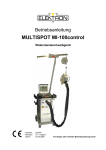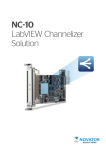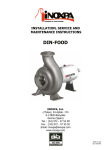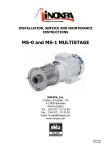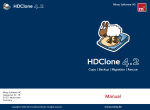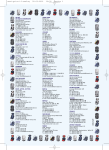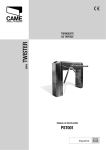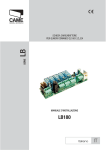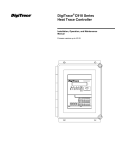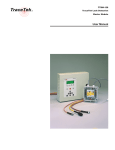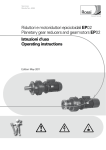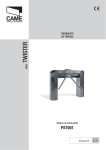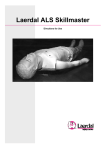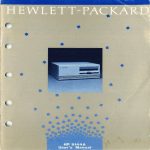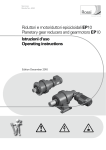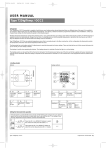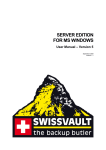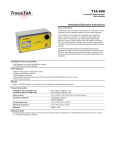Download Digitrace TControl-cont
Transcript
11.03/ Operating Manual BR 70.3011/1 Compact microprocessor controller DigiTrace TCONTROL-CONT-02 E ! ! Please note that we can not be held liable for any damages caused by ESD (electrostatic discharges). When returning chassis, assemblies or components, the rules of EN 100 015 “Protection of electrostatically endangered components” have to be observed. Use only the appropriate ESD packaging material for transport. All necessary settings are described in this Operating Manual. If any difficulties should still arise during start-up, you are asked not to carry out any manipulations on the unit which are not permitted. You could endanger your rights under the warranty. Please contact the nearest office or the main factory. Please read this Manual carefully before starting up the instrument. Keep this Manual in a place which is at all times accessible to all users. Please assist us to improve this Manual where necessary. Your suggestions will be most welcome. 26, 41 0 80 0 0 Al 2 Pb 1 Pb 2a 22, 41 350 20.0 20.0 0 rt Cy 1 Cy 21 db 24, 41 24, 41 16, 41 100 -100 0.6 0 Y1 Y2 dF rASd 31, 41 23, 41 0 23, 41 HYS 21 1.0 Y0 23, 41 HYS 1 2 1.0 23, 41 22, 41 22, 41 22, 41 22, 41 80 >2sec dt P 26, 41 2 Al 1 22, 41 Page Parameter level Default Settings SCL 1 0 0 850 600 -200 40 250 -50 0104 0013 2004 8714 0000 26, 40 17, 40 18, 40 18, 40 17, 40 17, 40 24, 28, 31, 39 26, 27, 29, 38 16, 20, 27, 37 Page a. This parameter appears only if a double setpoint controller has been configured as controller type. k= factory setting HySt OFFS SPH >2sec SCH SPL P C114 C113 C112 C111 Configuration level 5 4 1 2 3 Description . . . . . . . . . . . . . . . . . . . . . . . . . . . . . . . . . . . . . . . . . . . . . . . . . . . . . . . . . . . . . . 4 TCONTROL-CONT-02 Factory Settings . . . . . . . . . . . . . . . . . . . . . . . . . . . . . . . . . . . . . . . . 5 Installation . . . . . . . . . . . . . . . . . . . . . . . . . . . . . . . . . . . . . . . . . . . . . . . . . . . . . . . . . . . . . . . 6 3.1 Dimensions . . . . . . . . . . . . . . . . . . . . . . . . . . . . . . . . . . . . . . . . . . . . . . . . . . . . . . . . . . 6 3.2 Fitting in position and removing the controller chassis . . . . . . . . . . . . . . . . . . . . . . . . . 7 3.3 Cleaning the front panel . . . . . . . . . . . . . . . . . . . . . . . . . . . . . . . . . . . . . . . . . . . . . . . . . 7 Electrical connection . . . . . . . . . . . . . . . . . . . . . . . . . . . . . . . . . . . . . . . . . . . . . . . . . . . . . . 8 4.1 Notes on installation . . . . . . . . . . . . . . . . . . . . . . . . . . . . . . . . . . . . . . . . . . . . . . . . . . . 8 4.2 Connection diagram . . . . . . . . . . . . . . . . . . . . . . . . . . . . . . . . . . . . . . . . . . . . . . . . . . 10 Operation . . . . . . . . . . . . . . . . . . . . . . . . . . . . . . . . . . . . . . . . . . . . . . . . . . . . . . . . . . . . . . 11 5.1 Displays and keys . . . . . . . . . . . . . . . . . . . . . . . . . . . . . . . . . . . . . . . . . . . . . . . . . . . . 11 5.2 Principle of operation . . . . . . . . . . . . . . . . . . . . . . . . . . . . . . . . . . . . . . . . . . . . . . . . . . 12 5.3 Entering setpoints and parameters . . . . . . . . . . . . . . . . . . . . . . . . . . . . . . . . . . . . . . . 14 5.4 Entering the configuration codes . . . . . . . . . . . . . . . . . . . . . . . . . . . . . . . . . . . . . . . . . 14 Contents Contents 7 6 Configuration . . . . . . . . . . . . . . . . . . . . . . . . . . . . . . . . . . . . . . . . . . . . . . . . . . . . . . . . . . . 15 6.1 Process value input . . . . . . . . . . . . . . . . . . . . . . . . . . . . . . . . . . . . . . . . . . . . . . . . . . . 16 6.2 Setpoint limits . . . . . . . . . . . . . . . . . . . . . . . . . . . . . . . . . . . . . . . . . . . . . . . . . . . . . . . 18 6.3 Logic inputs . . . . . . . . . . . . . . . . . . . . . . . . . . . . . . . . . . . . . . . . . . . . . . . . . . . . . . . . . 19 6.4 Controller . . . . . . . . . . . . . . . . . . . . . . . . . . . . . . . . . . . . . . . . . . . . . . . . . . . . . . . . . . . 21 6.5 Limit comparators . . . . . . . . . . . . . . . . . . . . . . . . . . . . . . . . . . . . . . . . . . . . . . . . . . . . 25 6.6 Outputs . . . . . . . . . . . . . . . . . . . . . . . . . . . . . . . . . . . . . . . . . . . . . . . . . . . . . . . . . . . . 27 6.7 Display . . . . . . . . . . . . . . . . . . . . . . . . . . . . . . . . . . . . . . . . . . . . . . . . . . . . . . . . . . . . . 29 6.8 Ramp function . . . . . . . . . . . . . . . . . . . . . . . . . . . . . . . . . . . . . . . . . . . . . . . . . . . . . . . 30 6.9 Programme controller . . . . . . . . . . . . . . . . . . . . . . . . . . . . . . . . . . . . . . . . . . . . . . . . . 32 6.10 Self-optimisation . . . . . . . . . . . . . . . . . . . . . . . . . . . . . . . . . . . . . . . . . . . . . . . . . . . . . 35 Appendix . . . . . . . . . . . . . . . . . . . . . . . . . . . . . . . . . . . . . . . . . . . . . . . . . . . . . . . . . . . . . . . 37 7.1 Configuration code and parameter tables . . . . . . . . . . . . . . . . . . . . . . . . . . . . . . . . . . 37 7.2 Alarm messages . . . . . . . . . . . . . . . . . . . . . . . . . . . . . . . . . . . . . . . . . . . . . . . . . . . . . 42 7.3 Technical data . . . . . . . . . . . . . . . . . . . . . . . . . . . . . . . . . . . . . . . . . . . . . . . . . . . . . . . 43 Contents Description ■ 2 parameter sets with parameter set switching ■ 2 setpoints with setpoint switching ■ 1 limit comparator ■ Programmable input filter ■ Programme function ■ Ramp function ■ Self-optimisation ■ Programmable single / double setpoint controller or proportional controller with PID structure. 1 or or Logic input 1 for floating contact Logic input 2 for floating contact 110-240 V AC 48-63 Hz Process value input for Pt 100, Pt 1000, thermocouples or standard signals Output 5 - logic 5V Output 4 - logic 5V Output 3 - relay Output 2 - relay Output 1 - relay 4 1 Description Control Mode: Input: Output Relay K1 See Section 6.5 lk1 — lk8 Delivery package: - controller - 1 seal - 1 mounting frame - Operating Manual BR 70.3011 Alarms Limit Comparators TCONTROL-CONT-02 Factory Settings O function for process heating Pt 100 (3 wire) Control Output (setpoint 5°C, hysteresis 2) Relay K2 Alarm (Limit Comparator) (set as low temperatur alarm 2° C, hysteresis 0) Alarm (limit comparator) Relay K3 (set as high temperature alarm 80°C, hysteresis 0) Supply Voltage 110 - 240 V + 10/-15 % Control Funktion See48 Section AC - 63 Hz6.4 Single Control O Funktion on/off Software Selectable Settings Single Control S Funktion on/off PID Control Control ProcessFunktion value Input See SeeSection Section6.1 6.4 Linearised transducers Pt 100Control Single Funktion 4O— 20 mA on/off Pt 1000 Single S Funktion on/off Fe-ConControl J PID Control Cu-Con U Fe-Con Lvalue Input Process See Section 6.1 NiCr-Ni K Pt 100 Linearised transducers Pt 1000 4 - 20mA Fe-Con J Cu-Con U Fe-Con L NiCr-Ni K 2 5 2 TCONTROL-CONT-02 Factory Settings Installation Dimensions 3 3.1 6 3 Installation Cleaning the front panel The front panel can be cleaned with the usual wash and rinse agents and cleaners. It has a limited degree of resistance to organic solvents (e. g. petrol, benzene, P1, xylene and similar). Do not use any high-pressure cleaners. 3.3 h Press together the knurled areas (top and bottom) on the front panel and pull out the controller chassis. h From the back of the panel, push the mounting frame onto the instrument housing and press it against the back of the panel, compressing the springs, until the latches snap into the notches provided and it is securely fixed in position. h Insert the controller from the front into the panel cut-out. Seal Fitting in position and removing the controller chassis h Fit the seal provided onto the instrument housing 3.2 7 3 Installation Notes on installation 4.1 - Run input, output and supply lines separately and not parallel to each other. - Electromagnetic compatibility conforms to the standards and regulations listed under Technical Data. - A current limiting resistor interrupts the supply circuit in case of a short-circuit. The external fuse of the supply should not be rated above 1 A (slow). The load circuit must be fused for the maximum relay current in order to prevent welding of the output relay contacts in case of an external short-circuit. - If contact with live parts is possible when working on the instrument, it has to be isolated on both poles from the supply. - The electrical connection must only be carried out by properly qualified personnel. - The choice of cable, the installation and the electrical connection must conform to the requirements of VDE 0100 “Regulations on the Installation of Power Circuits with nominal voltages below 1000 V” or the appropriate local regulations. Electrical connection 4 8 4 Electrical connection - Apart from faulty installation, there is a possibility of interference or damage to controlled processes due to incorrect settings on the controller (setpoint, data of parameter and configuration levels, internal adjustments). Safety devices independent of the controller, such as overpressure valves or temperature limiters /monitors, should always be provided and should be capable of adjustment only by specialist personnel. Please refer to the appropriate safety regulations in this connection. Since auto-tuning (self-optimisation) can not be expected to handle all possible control loops there is a theoretical possibility of unstable parameter settings. The resulting process value should therefore be monitored for its stability. - The instrument is not suitable for installation in hazardous areas. - Do not connect any additional loads to the supply terminal of the instrument. - Sensor and interface lines should be arranged as twisted and screened cables. Do not run them close to current-carrying components or cables. 9 4 Electrical connection Connection diagram The electrical connection must only be made by properly qualified personnel. 4.2 V Logic input 1+2/ Output 4+5 Process value input Alarm output (K3, high temp.) Control ouput (K1) Alarm output (K2, low temp.) AC 110-240V Supply 10 4 Electrical connection Operation Displays and keys 5 5.1 Process value display red, 10 mm, 4 digits Setpoint display green, 7 mm, 4 digits PGM key to select the parameters Decrement key to alter values Increment key to alter values EXIT key to quit the levels LED for ramp / programme function lights up when configured; green LED for status indication for outputs 1 to 3; yellow (1) (2) (3) (4) (5) (6) (7) (8) 11 5 Operation Principle of operation Operating level Here the setpoints SP1 and SP2 are input and the profile segments of the programme function are programmed (if the programme function is configured). v Section 5.3 Standard display The displays show the process value and the active setpoint or the programme / ramp setpoint. The active setpoint can be changed here. h Return to standard display with X h Change to the next parameter with P h Change to the next level with P (Press key for at least 2 sec!) Generally, the following applies: 5.2 12 5 Operation Time-out If no operation occurs, the controller returns automatically to standard display after approx. 30 sec. Configuration level The basic functions of the controller are set here. Settings can only be made after leaving the parameter level via the y.0 parameter. v Section 6.4 Parameter level The limit values of the limit comparators and the controller parameters are programmed here. The instrument has two parameter sets. Display switching of the parameter sets is via parameter Pb.1. 13 5 Operation Entering setpoints and parameters or abort the input with X Entering the configuration codes h Select the digit with D (digit flashes!) h Alter the value with I h Confirm the code with P 5.4 v Section 6.2 (setpoint limits) The value alters only within the permitted range of values. The setpoint (parameter) is accepted automatically after approx. 2 sec; display flashes briefly h Decrease the setpoint (parameter) with D h Increase the setpoint (parameter) with I Example: Altering the setpoint in standard display Parameters and setpoints are input and altered by continually altering the value. The change speeds up the longer the key is held down. 5.3 14 5 Operation Configuration H v Section 7.1 For the experienced user, the parameters and configuration codes are summarised in the tables which are provided in the Appendix. Presentation The configuration codes have 4 positions. For functionally relevant positions, the kind of function and its selection possibility is described in the appropriate column. Positions which are not relevant for the function are marked with an “X” in the column. h Enter the parameters and configuration codes into the instrument h Enter the parameter values and the configuration codes in the table provided for this purpose on the back cover. The parameters and configuration codes are listed in the order of their appearance. h Familiarise yourself with the controller functions The parameter and the configuration codes are listed in the sequence in which they appear within the level structure. The following procedure is however recommended: The following sections describe the functions of the instrument with their relevant parameters and settings. 6 15 6 Configuration Process value input k= factory setting X = position functionally not relevant C111 Transducer Pt 100 Pt 1000 Fe-Con L NiCr-Ni K Pt10Rh-Pt S Pt13Rh-Pt R Pt30Rh-Pt B Cu-Con U NiCrSi-NiSi N Fe-Con J Standard signal 0 — 20 mA Standard signal 4 — 20 mA Filter time constant to adapt the digital input filter (0 sec = filter off) 0.6 sec dF 0.0—100.0 sec factory-set Notes Parameter Value range The process variable is fed into the controller via the process value input. 6.1 0 1 2 3 4 5 6 7 8 9 A b X X X 16 6 Configuration 0 -1999 to +9999 digit1 OFFS Process value correction (offset) The offset can be used to correct the measured value by a certain amount up or down. Examples: Measured value Offset Displayed value 294.7 + 0.3 295.0 295.3 – 0.3 295.0 SCL and SCH are simultaneously the calibration for the process value output v Section 6.6 Start /end of value range for standard signals Example: 0—20 mA→20 — 200 °C: SCL = 20 / SCH = 200 On a display with one or two decimal places the value range and the factory setting change accordingly (e. g. 1 decimal place → value range: -199.9 to +999.9). 250 -1999 to +9999 digit1 SCH 1. -50 -1999 to +9999 digit1 factory-set Notes SCL Parameter Value range 17 6 Configuration Setpoint limits Setpoint limits Setpoint inputs below or above these limits are not accepted. The value of SPL / SPH flashes on the display. Display start /end with external setpoint input. Low/high setpoint limit for SP1 and SP2. Example: 4 — 20 mA → 0 — 250 °C: SPL = 0, SPH = 250 On displays with one or two decimal places the value range and the factory setting change accordingly (e. g. 1 decimal place → value range: -199.9 to +999.9). 600 -1999 to +9999 digit1 SPH 1. -40 -1999 to +9999 digit1 factory-set Notes SPL Parameter Value range 6.2 18 6 Configuration Logic inputs No operation by keys No access to parameter and configuration level No start of self-optimisation Programme /ramp stopped Programme /ramp (re)started Setpoint SP2 is activated. Parameter set 2 is activated. („ Pb.1) Limit comparators are activated. Operation is possible by keys Access possible to parameter and configuration level. Start of self-optimisation is possible. Programme /ramp running (when configured!) – Setpoint SP1 is activated. Parameter set 1 is activated. (, Pb.1) Limit comparators are off. Key inhibit Level inhibit Programme/ ramp stop Programme/ ramp start Setpoint switching Parameter set switching Enabling the limit comparators Various operating functions can be activated via the two logic inputs. 6.3 19 6 Configuration H Different functions can be combined. k= factory setting X = position functionally not relevant C111 Logic inputs 1 (BE1) and 2 (BE2) no function Key inhibit Level inhibit Programme /ramp stop Programme /ramp start Setpoint switching Parameter set switching Enabling limit comparators X X BE1 BE2 0 0 1 1 2 2 3 3 4 4 5 5 6 6 7 7 20 6 Configuration Controller The parameter set which is displayed is shown by lit-up segments on parameter Pb.1. h Change between the display of the parameter sets with P , when parameter Pb.1 is displayed (hold key down for at least 2 sec!). The controller has two parameter sets; a logic input can be used to switch between them. Both parameter sets can be displayed for setting the parameters. Selecting the parameter set Controller functions 1 segment 2 segments The controller type is set here, and the controller is adjusted to the process. 6.4 = parameter set 1 = parameter set 2 21 6 Configuration 0—9999 sec 0—9999 sec 0.5—999.9 sec 0.5—999.9 sec dt rt Cy 1 Cy 2 1. 0 0—9999 digit1 Pb 2 Duration of switching cycle 1 (controller output 1) Duration of switching cycle 2 (controller output 2) Duration of switching cycle on switching outputs. The cycle time should be selected so that the energy supply to the process is virtually continuous while the switching elements are not subject to excessive wear. Reset time Influences the I action of the controller. If rt=0, the controller has no I action. Derivative time Influences the D action of the controller. If dt=0, the controller has no D action. Proportional band 1 (controller output 1) Proportional band 2 (controller output 2) Influences the P action of the controller If Pb = 0, the controller structure is ineffective. On the display with one or two decimal places the value range and the factory setting change accordingly (e. g. 1 decimal place → value range: -199.9 to +999.9). 20.0 sec 20.0 sec 350 sec 80 sec 0 0—9999 digit1 factory-set Notes Pb 1 Parameter Value range Controller structure The controller structure is defined through parameters Pb, dt and rt. Example: PI → Pb≠0, dt=0, rt≠0 22 6 Configuration 2 1.0 1.0 0 — 9999 digit1 0 — 9999 digit1 -100 — 100 % HYS 1 HYS 2 Y0 0% 0.0 0 — 1000 digit1 Working point Output at x=w Differential 1 (controller output 1) Differential 2 (controller output 2) For controllers with Pb=0 Contact spacing For switching double-setpoint controllers factory-set Notes db Parameter Value range 23 6 Configuration -100 to +100 % Y2 H 1. On the display with one or two decimal places the value range and the factory setting change accordingly (e. g. 1 decimal place → value range: -199.9 to +999.9). k= factory setting X = position functionally not relevant 0 1 2 3 4 X X X On controllers without controller structure (Pb = 0) it is necessary that Y1 = 100% and Y2 = -100% C113 Controller type Single-setpoint controller O function Single-setpoint controller S function Double-setpoint controller Proportional controller with falling characteristic (indirect action) Proportional controller with rising characteristic (direct action) -100 % 100 % 0—100 % Y1 Maximum /minimum output Example: proportional controller with falling characteristic (indirect action) factory-set Notes Parameter Value range 24 6 Configuration Limit comparators lk2 lk5 lk8 lk1 lk4 lk7 Functions of the limit comparators lk1— lk6: Monitoring referred to the setpoint lk7 / lk8: Monitoring referred to a fixed value AL. lk6 lk3 The measurements of the two inputs can be monitored with reference to the setpoint or a fixed value using two limit comparators. 6.5 25 6 Configuration 80 -1999 to +9999 digit1 AL 2 1. -1999 to +9999 digit1 1 LK1 LK2 X X 0 00 1 1 2 2 2 3 3 4 4 5 5 6 6 7 77 8 8 Switching differential of the limit comparators factory-set Notes X = position functionally not relevant Limit limit comparator 2 Limit limit comparator 1 In the display with one or two decimal places the value range and the factory setting change accordingly (e. g. 1 decimal place → value range: -199.9 to +999.9). HySt Parameter Value range k= factory setting C112 Limit comparator 1 (LK1) and 2 (LK2) no function lk 1 (process value input) lk 2 (process value input) lk 3 (process value input) lk 4 (process value input) lk 5 (process value input) lk 6 (process value input) lk 7 (process value input) lk 8 (process value input) 2 -1999 to +9999 digit1 factory-set Notes AL 1 Parameter Value range 26 6 Configuration Outputs k= factory setting X = position functionally not relevant C112 Output signal on overrange Output 0 %, limit comparators OFF Output 100 %, limit comparators OFF Output -100 %, limit comparators OFF Output 0 %, limit comparators ON Output 100 %, limit comparators ON Output -100 %, limit comparators ON k= factory setting X = position functionally not relevant C111 Output 4 (A4) and 5 (A5) no function Controller output 1 Controller output 2 Limit comparator output 1 Limit comparator output 2 Programme end The five outputs can be freely assigned to the functions. 6.6 X X X 0 1 2 3 4 5 X X A4 A5 0 0 8 8 9 9 A A b b C C 27 6 Configuration X = position functionally not relevant = factory setting X = position functionnally not relevant no function Controller output 1 (function: 0 - 20mA/0 - 10V/switching) Controller output 2 (function: 0 - 20mA/0 - 10 V/switching) Limit comparator output 1 (function: switching) Limit comparator output 2 (function: switching) Programme end (funciton: switching) Controller output 1 (function: 4 - 20 mA/2 - 10V) Controller output 2 (function: 4 - 20 mA/2 - 10V) Process value output (function: 0 - 20 mA/0 - 10V) Process value output (function: 4 - 20 mA/2 - 10V) C114 Output 3 (K3) k= factory setting C113 Output 1 (K1; relay) and 2 (K2; relay) no function Controller output 1 Controller output 2 Limit comparator output 1 Limit comparator output 2 Programme end X X X X X K1 0 1 2 3 4 5 0 1 2 3 44 5 6 7 8 9 K3 K2 0 1 2 3 4 5 28 6 Configuration Display h Display the software version and unit of the process value with P + I (hold keys down!) Displaying the unit and software version k= factory setting X = position functionally not relevant C112 Decimal places /unit no decimal place, degree Celsius one decimal place, degree Celsius two decimal places, degree Celsius no decimal place, degree Fahrenheit one decimal place, degree Fahrenheit two decimal places, degree Fahrenheit X X 0 1 2 3 4 5 X The number of the decimal places when displaying process value and setpoint in the standard display is defined here. In addition, the unit of the process value is determined. 6.7 29 6 Configuration Ramp function Action on power failure When the supply is restored, the controller accepts the current process value as ramp setpoint and continues the ramp function with the set parameters. Action on sensor break On sensor break the ramp function is interrupted. The outputs act as for overrange or underrange (can be configured). When the fault has been rectified, the controller accepts the current process value as ramp setpoint and continues the ramp function. A rising or falling ramp function is possible. When the power is switched on, the ramp function starts with the current process value and the setpoint runs according to the selected gradient until the ramp end point SP is reached. The ramp end point is entered at the setpoint input (SP1, SP2). When the ramp end point is reached, then the ramp setpoint is equal to SP. 6.8 30 6 Configuration k= factory setting X = position functionally not relevant C113 Ramp function Ramp function off Ramp function (time base: minutes) Ramp function (time base: hours) X 1. In the display with one or two decimal places, the value range changes to 0.0 — 99.9 digit/h (digit/min.) ramp gradient 0 rASd 0 —999 digit /h or digit /min1 factory-set Notes Parameter Value range h Re-start the ramp with D + I or via the logic input Re-starting the ramp 0 5 6 X X Ramp stop Activating the ramp stop via a logic input holds the ramp function. The setpoint display flashes. After the ramp stop has been de-activated, the ramp function continues with the ramp setpoint at the time of the ramp stop. 31 6 Configuration Programme controller It is possible to implement a setpoint programme with up to 4 profile segments. The segment setpoints (SP00 — SP03) and the segment times (t00 — t03) are set at the operating level. The time base can be configured in seconds or minutes (max. segment time 9999 min.). 6.9 32 6 Configuration Re-starting the programme h Re-start the programme with D + I or via the logic input Programme stop The programme is held by activating the programme stop via a logic input. The setpoint display flashes. After the programme stop has been de-activated, the programme continues with the setpoint at the time of the programme stop. Action on power failure When the supply is restored, the programme starts at the process value. Action on sensor break On sensor break the programme is interrupted. The outputs act as for overrange or underrange (can be configured). When the fault has been rectified, the programme continues with the process value. v Section 6.6 “Outputs” The programme starts at the process value, i. e. the profile is searched to find a setpoint which corresponds to the process value at the instant of start or power-on. ((1), (2), (3)). The profile then continues from this point. If the process value is outside the profile, a start is made at the first profile segment and the segment setpoint is then approached with the gradient of the first segment (positive or negative). The programme can either be run through once or repeated cyclically. In addition, a programme end signal can be output and the programme can be held. 33 6 Configuration k= factory setting X = position functionally not relevant C113 Programme function Programme controller off Programme controller (timebase: seconds) Programme controller (timebase: seconds; cyclic) Programme controller (timebase: minutes) Programme controller (timebase: minutes; cyclic) X 0 1 2 3 4 X X 34 6 Configuration Self-optimisation With a small deviation between setpoint and process value, e.g. when the control loop has stabilised, a forced oscillation about the setpoint is produced. If there is a large deviation between process value and setpoint when SO is activated, a switching level is determined about which the process variable performs a forced oscillation during the SO procedure. The switching level is chosen so that the process value does not exceed the setpoint, if possible. The following controller parameters are defined: rt, dt, Pb1, Pb2, Cy1, Cy2, dF Self-optimisation determines the controller parameters for PID or PI controllers. 6.10 35 6 Configuration H Starting SO is not possible with active level inhibit. The active parameter set is optimised. With active ramp /programme function, the ramp /programme sequence is stopped during self-optimisation. h Store the parameters with X (Hold down key for at least 2 sec!) If "tune" does not flash any longer, self-optimisation is terminated and the controller functions with the parameters which have been established. h Abort with X (while self-optimisation is running) h Start SO with X (hold down key for at least 2 sec !) Starting self-optimisation 36 6 Configuration Appendix 0 0 0 0 k= factory-set Process value input Pt 100 Pt 1000 Fe-Con L NiCr-Ni K Pt10Rh-Pt S Pt13Rh-Pt R Pt30Rh-Pt B Cu-Con U NiCrSi-NiSi N Fe-Con J 0 — 20 mA 4 — 20 mA 0 1 2 3 4 5 6 7 8 9 A b A4 8 9 A b C Output 4 (A4) and 5 (A5) Controller output 1 Controller output 2 Limit comparator output 1 Limit comparator output 2 Programme end A5 8 9 A b C BE1 BE2 0 0 1 1 2 2 3 3 4 4 5 5 6 6 7 7 Logic input 1 (BE1) and 2 (BE2) no function Key inhibit Level inhibit Programme/ramp stop Programme/ramp start Setpoint switching Parameter set switching Enabling the limit comparators 7.1 Configuration code and parameter tables C111 7 37 7 Appendix k= factory-set Limit comparator 1 (LK1) LK1 LK2 and 2 (LK2) no function 0 0 lk 1 (process value input) 1 1 2 lk 2 (process value input) 2 lk 3 (process value input) 3 3 lk 4 (process value input) 4 4 lk 5 (process value input) 5 5 lk 6 (process value input) 6 6 7 lk 7 (process value input) 7 8 lk 8 (process value input) 8 C112 Decimal places/ unit XXXX / °C XXX.X / °C XX.XX / °C XXXX / °F XXX.X / °F XX.XX / °F 28 07 01 44 0 1 2 3 4 5 Output 0 %, LK1+2 OFF Output 100 %, LK1+2 OFF Output -100 %, LK1+2 OFF Output 0 %, LK1+2 ON Output 100 %, LK1+2 ON Output -100 %, LK1+2 ON Output signal on overrange 0 1 2 3 4 5 38 7 Appendix k= factory-set Controller type 1-setpt. controller O function 1-setpt. controller S function 2-setpoint controller Proportional controller with falling characteristic Proportional controller with rising characteristic C113 4 0 1 2 3 Ramp function Ramp function time base: minutes Ramp function time base: hours Programme function Programme controller/ ramp function off Programme controller time base: seconds Programme controller time base: seconds; cyclic Programme controller time base: minutes Programme controller time base: minutes; cyclic 0 0 1 3 6 5 4 3 2 1 0 Output 1 (K1; relay) and 2 (K2; relay) no function Controller output 1 Controller output 2 Limit comparator output 1 Limit comparator output 2 Programme end 0 1 2 3 4 5 0 1 2 3 4 5 K1 K2 39 7 Appendix ! 0 0 0 1 . . 9 9 = factory-set 9600 baud, no parity 9600 baud, odd parity 9600 baud, even parity 4800 baud, no parity 4800 baud, odd parity 4800 baud, even parity Schnittstellenparameter E ! Geräteadresse Address 0 Address 1 . . Address 99 C114 0 1 2 3 4 5 0 1 4 Ausgang 3 (K3; Relais) no function Controller output (0...20mA/0...10V/switching) Controller output (0...20mA/0...10V/switching) Limit comparator output 1 (switching) Limit comparator output 2 (switching) Programme end (switching) Controller output (4...20mA/2...10V) Controller output (4...20mA/2...10V) Process value input (0...20mA/0...10V) Process value input (4...20mA/2...10V) 0 K3 00 1 2 3 4 5 6 7 8 9 40 -40 600 0 1 -1999 to +9999 digit1 -1999 to +9999 digit1 -1999 to +9999 digit1 -1999 to +9999 digit1 SPL SPH OFFS HySt Switching differential of limit comparators Process value correction (offset) Display end with external setpoint input Display start with external setpoint input End value of value range for standard signals Start value of value range for standard signals On displays with one or two decimal places the value range and the factory setting change accordingly (e. g. 1 decimal place → value range: -199.9 to +999.9). 250 -1999 to +9999 digit1 SCH 1. -50 -1999 to +9999 digit1 factory-set Notes SCL Parameter Value range The parameters of the configuration level 41 40 7 Appendix 0 0 20.0 s 0.0 1.0 1.0 0.6 s 0 0—9999 digit1 0—9999 digit1 0— 9999 sec 0— 9999 sec 0.5— 999.9 sec 0.5— 999.9 sec 0—1000 digit 1 0— 9999 digit 1 0— 9999 digit 1 -100— 100 % 0— 100 % -100 to +100 % 0.0— 100.0 sec 0 — 999 digit 1 Pb 1 Pb 2 dt rt Cy 1 Cy 2 db HYS 1 HYS 2 Y0 Y1 Y2 dF raSd 1. 80 -1999 to +9999 digit1 AL 2 Ramp gradient Filter time constant for adaptation Output limitation: minimum output Output limitation: maximum output Working point Switching differential 2 (controller output 2) Switching differential 1 (controller output 1) Contact spacing Switching cycle time 2 (controller output 2) Switching cycle time 1 (controller output 1) Reset time Derivative time Proportional band 2 (controller output 2) Proportional band 1 (controller output 1) Limit for limit comparator 2 Limit for limit comparator 1 On displays with one or two decimal places the value range and the factory setting change accordingly (e. g. 1 decimal place → value range: -199.9 to +999.9) -100 % 100 % 0% 20.0 s 350 s 80 s 2 -1999 to +9999 digit1 factory-set Notes AL 1 Parameter Value range Parameter level 42 41 7 Appendix H Display 7.2 The following events come under the heading over /underrange: - Sensor break /short-circuit - Measurement is outside the control range of the connected sensor - Display overflow The setpoint display flashes “1999”. The process value display indicates the process value. Over /underrange of the external setpoint. Limit comparators referred to the input for the external setpoint act according to the configuration of the outputs. Over /underrange of the process value. Controller and limit comparators referred to the process value input act in accordance with the configuration of the outputs. The process value display flashes “1999”. The setpoint display indicates the active setpoint Cause/response Description Alarm messages 43 42 7 Appendix Technical data Control range -200 +850 °C -200 +850 °C -200 +900 °C -200 +1200 °C -200 +1372 °C -200 +600 °C -100 +1300 °C 0 — 1768 °C 0 — 1768 °C 0 — 1820 °C scalable scalable Transducer Process value input Pt 1002 Pt 10002 Fe-Con L3 Fe-Con J3 NiCr-Ni K3 Cu-Con U3 NiCrSi-NiSi N3 Pt10Rh-Pt S3 Pt13Rh-Pt R3 Pt30Rh-Pt6Rh B3 0 — 20 mA5 4 — 20 mA5 ≤ 0.1 % /≤ 25 ppm /°C ≤ 0.1 % / ≤ 25 ppm / °C ≤ 0.25 % / ≤ 100 ppm / °C ≤ 0.25 % / ≤ 100 ppm / °C ≤ 0.25 % / ≤ 100 ppm / °C ≤ 0.25 % / ≤ 100 ppm / °C ≤ 0.25 % / ≤ 100 ppm / °C ≤ 0.25 % / ≤ 100 ppm / °C ≤ 0.25 % / ≤ 100 ppm / °C ≤ 0.25 % / ≤ 100 ppm / °C4 ≤ 0.1 % / ≤ 100 ppm / °C ≤ 0.1 % / ≤ 100 ppm / °C Measurement accuracy/ Ambient temperature error These values include the linearisation tolerances. Inputs 7.3 X X X X X X X X X X – X X X – – – – – – – – – X monitoring1 Sensor break Short-circuit Measurement circuit 44 43 7 Appendix 3. 4. 5. 2. 1. X = recognised, – = not recognised The outputs move to a defined status. Pt 100, Pt 1000 in 2- or 3-wire circuit Lead compensation: Not required for 3-wire circuit. When used with a resistance thermometer in 2-wire circuit, lead compensation can be provided by an external lead compensation resistor. (Rcomp = Rline). In addition, the lead resistance can be compensated in software through process value correction. Temperature compensation: internal Within the range of 300 — 1820 °C Voltage drop ∆ue less than 1 V 45 44 7 Appendix 0 /5 V Rload 250 Ω min. Permitted storage temperature range: -40 to +70 °C Permitted ambient temperature range: 0 to + 55 °C Electrical connection: through screw terminals for wires up to 1.5 mm2 and core end sleeves Power consumption: 5 VA approx. Supply: 110 — 240 V +10/-15 % AC 48 — 63 Hz Data back-up: EEPROM Sampling time: 210 msec 250 msec on programme controller Controller type: can be configured as single / double setpoint or proportional controller A/D converter: resolution better than 15 bit General controller data 2. Logic outputs: n.o. (make) 1. Relay Relay outputs 1. outputs K1/K2: K1 / K2:n.o. (make)contact) contact) Rating 3A, 250 V AC on resistive load 5 Rating 3 A, 250 V AC on resistive load Contact life more than 5 10 5operations at rated load life more 5 •Contact) 10 operations at rated load (SPST) 1b.Contact Relay output K3:than 3 relay outputs, 2 logic outputs Outputs 46 45 7 Appendix Weight: 140 g Operating position: unrestricted for flush panel mounting to DIN 43 700, base material PC, with plug-in controller chassis Housing to NAMUR recommendation NE21, EN 50 081 Part 1, EN 50 082 Part 2 Electromagnetic compatibility to EN 61 010 clearances and creepage distances for - overvoltage category II - pollution degree 2 Electrical safety Protection: to EN 60 529 front IP65, rear IP20 Climatic conditions: relative humidity not to exceed 75 %, no condensation 47 46 7 Appendix Danmark Tyco Thermal Controls Nordic AB Stationsvägen 4 S-430 63 Hindås Tel. 70 11 04 00 Fax 70 11 04 01 Çeská Republika Raychem HTS s.r.o. Novodvorská 82 14200 Praha 4 Phone (02) 41 00 92 15 Fax (02) 41 00 92 19 België / Belgique Tyco Thermal Controls Staatsbaan 4A 3210 Lubbeek Tel. (016) 213 511 Fax (016) 213 610 Tyco offices Hrvatska ELGRI d.o.o. S. Mihalica 2 10000 Zagreb Tel. (1) 6050188 Fax (1) 6050187 France Tyco thermal Controls SA B.P. 738 95004 Cergy-Pontoise Cedex Tél. 0800 906045 Fax 0800 906003 Apdo. 1326-43080 43007 Tarragona 43007 Tarragona Tel. (34) 977 290 039 Fax (34) 977 290 032 España Tracelec C/Josep V. Foix 10 Deutschland Tyco Thermal Controls GmbH Kölner Strasse 46 57555 Mudersbach Tel. 0800 1818205 Fax 0800 1818204 Nederland Tyco Thermal Controls b.v. Van Heuven Goedhartlaan 121 1181 KK Amstelveen Tel. 0800 0224978 Fax 0800 0224993 Magyaroszág Raychem Ges.m.b.H. Magyarországi Közvetlen Képviselet Grassalkovich ut 255. 1239 Budapest Tel. (1) 289 20 40 Fax (1) 289 20 45 Italia Tyco Electronics Raychem SPA Centro Direzionale Milanofiori Palazzo E5 20090 Assago, Milano Tel. (02) 57 57 61 Fax (02) 57 57 62 01 Polska Raychem Polska Sp. z.o.o. Tyco Thermal Controls ul. Farbiarska 69 C 02-862 Warszawa Tel. (022) 54 52 950 Fax (022) 54 52 951 Österreich Tyco Thermal Controls N.V. Lubbeek Office Wien Office Wien Brown-Boveri Strasse 6/14 2351 Wiener Neudorf Tel. (0 22 36) 86 00 77 Fax (0 22 36) 86 00 77-5 Norge Tyco Thermal Controls Norway AS Malerhaugveien 25 Postboks 6076 - Etterstad 0602 Oslo Tel. +47 66 81 79 90 Fax +47 66 80 83 92 Sverige Tyco Thermal Controls Nordic AB Stationsvägen 4 S-430 63 Hindås Tel. 0301-228 00 Fax 0301-212-10 www.tycothermal.com ROSSIÅ i drugie strany SNG RAJXEM 125315, g. Moskva Leningradskij prospekt, dom 72, ofis 807 Tel.: (095) 7211888 Faks: (095) 7211891 Suomi Tyco Thermal Controls Nordic AB Stationsvägen 4 S-430 63 Hindås Puh. 0800 11 67 99 Telekopio 0800 11 86 74 Tel. (041) 766 30 80 Fax (041) 733 30 81 United Kingdom Tyco Thermal Controls (UK) Ltd 3 Rutherford Road, Stephenson Industrial Estate Washington, Tyne & Wear NE37 United Kingdom NE373HX, 3HX, United Kingdom Phone 0800 96 90 13 Fax 0800 96 86 24 Schweiz / Suisse Tyco Thermal Controls N.V. Office Baar Haldenstrasse 5 Postfach 2724 6342Baar Baar 6342





















































